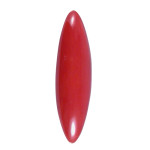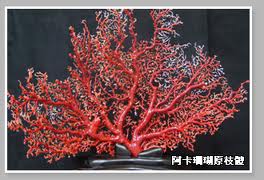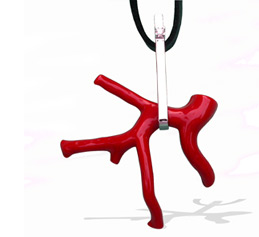 Corail vient du latin corallium et du grec gorgeia.
Corail vient du latin corallium et du grec gorgeia.
Le mot corail est ambigu car il désigne des organismes marins coloniaux appartenant à une très large « famille ». Ces coraux sont des animaux en forme de sac qui construisent un squelette externe calcaire ou kératineux.
On trouve des récifs de coraux partout dans le monde, des régions tropicales à la Mer du Nord et à la Méditerranée. Mais la plupart des coraux ne sont pas de qualité joaillerie. Le corail rouge (dans ses variétés corallium rubrum et corallium japonicum), qui peut dans les faits offrir des couleurs variant du blanc-rosé au rose (peau d’ange), et de l’orangé (saumon), jusqu’au fameux « sang de bœuf » que l’on peut trouver en Méditerranée, n’a rien de comparable avec les coraux des mers chaudes que l’on trouve même à faible profondeur, ces derniers sont parfois teints et ont une valeur marchande en décoration principalement.
Aspect
Le corail est constitué de carbonate de calcium (CaCO3) et de matières organiques. Très sensible, le corail ne peut se développer que dans des eaux entre 13 et 16 degrés Celsius.
Corallium rubrum est récolté par 70 à 130 mètres de fond, au sud de la Corse et au large de Naples par des coralliers.
Sa dureté est de 3,5, sa densité varie de 2,6 à 3,8 son indice de réfraction va de 1,486 à 1,658.
Son éclat doux, sa faible dureté et son opacité sont des qualités idéales pour y tailler des statuettes, des cabochons ou des perles.
Le corail étant poreux, il peut être teint et il est difficile de repérer les imitations. Le corail rouge naturel contient du carotène, mais cela ne peut être vérifié qu’en laboratoire. Mieux vaut donc s’adresser à des fournisseurs de confiance.
Provenance
Le « corallium rubrum » provient de Méditerranée occidentale, (golfe de Naples, sud de la Corse), et du nord des côtes africaines.
 La variété corallium japonicum est récoltée au large des îles japonaises d’Ogasawara et de Ryukyu, ainsi qu’au large des côtes de République Populaire de Chine, de Taiwan, du Vietnam et des Philippines.
La variété corallium japonicum est récoltée au large des îles japonaises d’Ogasawara et de Ryukyu, ainsi qu’au large des côtes de République Populaire de Chine, de Taiwan, du Vietnam et des Philippines.
La pêche en est aujourd’hui contrôlée car l’espèce est en danger et le ramassage avec des filets de chalutiers a fait d’immenses dégâts et dépeuplé les colonies.
La lenteur de la croissance du corail (moins d’un cm par an), fait qu’il faut 50 à 75 ans aux branches de corail pour atteindre une taille permettant d’être récolté.
Symbolique
Dans la mythologie grecque, l’origine du corail est liée à l’histoire de Persée.
Persée reçut la mission de tuer la Gorgone Méduse, créature maléfique à la chevelure de serpents et dont le regard pétrifie ceux qu’il atteint.
Armé d’un bouclier dont l’intérieur servait de miroir pour éviter d’être pétrifié par le regard du monstre et d’une épée offerte par Hermès, Persée triompha de Méduse et lui coupa la tête. Le sang de celle-ci aurait touché le varech en le pétrifiant et le transformant en corail. Le corail se dit en grec ‘Gorgeia’, car Méduse était l’une des trois Gorgones.
Les noces de corail symbolisent les 11 ans de mariage dans le folklore français.
Comment je l’aime
Je l’aime en boule et associé aux perles de Tahiti, (voir les boucles d’oreilles «Cerises» d’Ann Gérard), mais aussi sculpté sur les bijoux de Massimo Izzo ou en branches choisies et mises en scène par la créatrice Stefania Minardi.
Les branches de corail sont sculptées ou polies depuis des milliers d’années. Des objets magnifiques sont exposés en Italie au musée archéologique de Naples et dans certaines collections privées de Torre el Greco.

